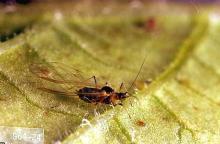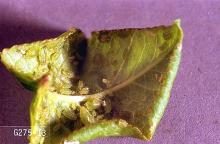Green peach aphid (Myzus persicae)
Mealy plum aphid (Hyalopterus pruni)
Rusty plum aphid (Hysteroneura setariae)
Pest description and crop damage Several aphid species attack peaches and nectarines, including the green peach aphid, mealy plum aphid, and rusty plum aphid. Green peach aphid adults have yellowish-green, pear-shaped bodies about 0.05 inch in length. At certain times each year, adults may develop wings and migrate to other hosts. Nymphs look like adults but are smaller and wingless. Adults of the mealy plum aphid are pale bluish green to light purple with a white, powdery coating. The rusty plum aphid is rusty brown or deep purple with white bands on the legs and antennae.
Aphids feed initially on the shoot tips, which can cause growth stunting and malformation at the tips of young trees. On older trees, fruit set may be reduced in subsequent years if aphid populations are high. Aphid honeydew production can cause sooty mold problems on fruit. Green peach aphid is a more serious problem on nectarines which lack "fuzz" on the fruit's surface.
Biology and life history These aphids overwinter as eggs in crevices and twigs. The eggs hatch near budbreak, then the nymphs feed on unopened buds and, later, the undersides of the leaves. Leaves curl and protect the aphids as they feed. After two to three generations, winged forms are produced that migrate to summer hosts such as weeds, ornamental plants, vegetables, or plants in the mustard family. After several generations, in the autumn, the winged forms migrate back to the fruit trees to mate and lay the overwintering eggs.
Pest monitoring Observe shoots for eggs and newly hatched aphids prior to budbreak as management is best undertaken while aphid abundance is the lowest and before leaves begin to curl about and protect aphid colonies.
Management-biological control
Aphids are susceptible to several fungal pathogens, including Beauveria bassiana available as a commercial product. Aphids have many natural enemies, which include lady beetles, syrphid fly larvae, lacewing larvae, and parasitic wasps. Avoid broad-spectrum insecticide applications that would disrupt these natural enemies.
Management-cultural control
Home orchardists: Wash aphids from plants with a strong stream of water or by hand-wiping them from the fruit tree. Aphid populations tend to be higher in plants that are fertilized liberally with nitrogen. Avoid excessive watering which, together with nitrogen applications, produces flushes of succulent growth.
Management-chemical control: HOME USE
Dormant-season spray
Apply sprays using enough water to cover the entire tree thoroughly including small limbs. Apply only during dormant or delayed-dormant period.
- horticultural mineral oil-Some formulations are OMRI-listed for organic use.
Growing-season spray
- acetamiprid-Toxic to bees.
- azadirachtin (neem extract)-Some formulations are OMRI-listed for organic use.
- carbaryl-Highly toxic to bees.
- esfenvalerate-Highly toxic to bees.
- gamma-cyhalothrin-Highly toxic to bees.
- horticultural mineral oil-Some formulations OMRI-listed for organic use.
- imidacloprid-Soil drenches may have residual activity in woody plants lasting for 12 or more months. If short-term management is the goal, consider other approaches. Highly toxic to bees.
- insecticidal soap-Not recommended for use on yellow-skin nectarine varieties. Some formulations are OMRI-listed for organic use.
- kaolin clay-Repels some insect pests when applied as a spray to leaves, stems, and fruit. OMRI-listed for organic use.
- lambda-cyhalothrin-Highly toxic to bees.
- plant-derived essential oils-Some have shown efficacy against aphids. Some formulations are OMRI-listed for organic use.
- pyrethrins-Some formulations are OMRI-listed for organic use. Highly toxic to bees.
- zeta-cypermethrin-Highly toxic to bees.
Management-chemical control: COMMERCIAL USE
Dormant and delayed-dormant sprays
- diazinon (Diazinon AG500) at 1 pint/100 gal water (1.5 to 3 pints/A) + horticultural mineral oil (rates vary; check product label). REI 4 days. Diazinon is limited to one application per season as a dormant spray. Do not apply more than 4 lb product or 6 gal oil per acre. Apply only once during the dormant season.
- esfenvalerate (Asana XL) at 2.0 to 5.8 fl oz/100 gal water (4.8 to 14.5 fl oz/A) + horticultural mineral oil (rates vary; check product label). REI 12 hr.
- horticultural mineral oil-Rates vary; check product label. REI varies; check product label. Some formulations are OMRI-listed for organic use.
- phosmet (Imidan 70-W) at 1.5 to 3 lb ai/A (2.12 to 4.25 lb/A). Not to exceed 4.25 lb product or 3 lb ai /A per year. REI 7 days. Not labeled for peach or plum aphid but has been found to be effective. Extremely toxic to fish.
Petal fall spray
- acetamiprid (Assail 70WP) at 1.1 to 2.3 oz/A. REI 12 hr. PHI 7 days.
- diazinon (Diazinon 50W) at 1 lb/100 gal water/A (100 gal/A min). Do not exceed 4 lb/A per year (2 lb ai/A per year). REI 4 days. PHI 21 days. Do not exceed one in-season foliar application per year.
- imidacloprid (Prey 1.6F) 4 to 8 fl oz/A. REI 12 hr. PHI 0 day.




